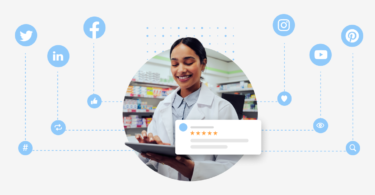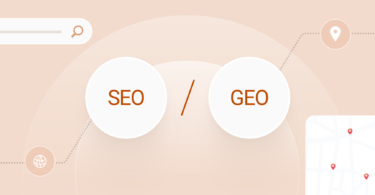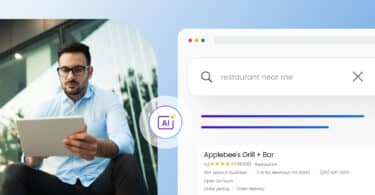You’ve spent countless hours crafting the perfect social media post. You hit publish and eagerly wait for the likes and comments to roll in. But is your post reaching its intended audience? And how many times is it being viewed? This is where reach and impressions come in – two critical metrics that can make all the difference in measuring your post’s success.
Reach is the number of unique people who saw your post, while impressions count the number of times your post appeared on screens. Imagine you shared a great video testimonial of your customer on LinkedIn. The reach of that post is the total number of people who saw it. Impressions are how many times that video popped up on someone's screen, even if the same person saw it multiple times.
Both metrics are essential for gauging performance but serve different purposes and require distinct strategies to optimize.
Let’s understand everything you need to know about them and how prioritizing them will benefit your social media management.
Table of contents
- What is reach?
- What are impressions?
- How do you increase impressions?
- Reach vs. impressions: Which is more important?
- Reach vs. impressions vs. engagement
- Which metric to track and when?
- Role of reach and impressions on different platforms
- Do reach and impressions matter in paid marketing?
- Can viral marketing impact reach and impressions?
- Reach vs. impressions: Are these only vanity metrics on social media?
- FAQs on reach vs. impressions
- Birdeye Social – The tool you need to track your content’s reach and impressions
What is reach?
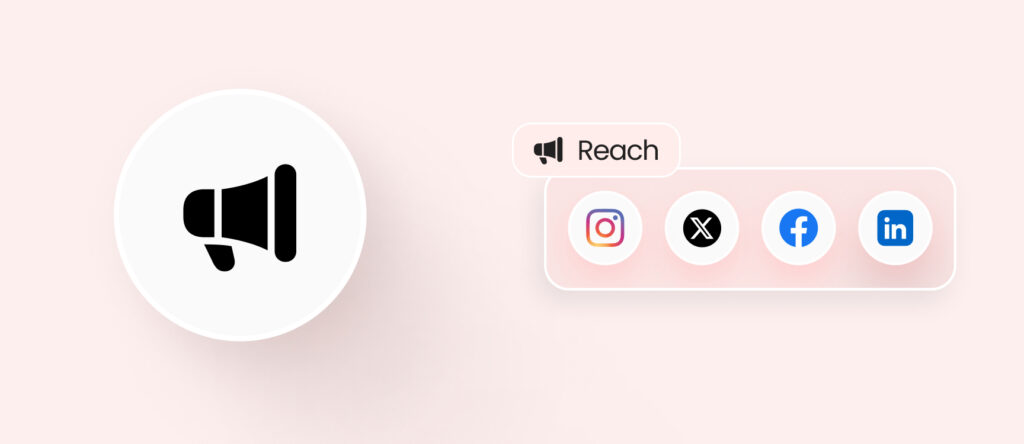
Reach is a fundamental metric in social media analytics that measures the total number of unique individuals exposed to your content within a specific timeframe.
In simpler terms, it’s about determining how many different people saw your post.
How do social media platforms calculate reach?
They use complex algorithms to determine reach. However, the basic principle is straightforward: if a user sees your content, they’re counted as part of your reach, regardless of whether they engage with it.
It's important to note that if the same person sees your post multiple times, they're still only counted once in your social media reach.
Why should you care about your content’s reach?
Understanding your reach is crucial for several reasons:
- Audience growth: A high reach indicates that your content reaches many people, leading to potential audience growth.
- Brand awareness: A wider reach means more people are exposed to your brand, increasing brand visibility and recognition.
- Content performance: Comparing reach across different posts can help you identify content that resonates best with your audience.
Types of reach: Organic vs. paid
It’s essential to differentiate between organic and paid reach:
- Organic reach: This is the number of people who see your content without any paid promotion.
- Paid reach: This refers to the number of people who see your content because you’ve invested in advertising.
While paid reach can provide a quick boost, organic reach is often more valuable as it indicates a genuine interest in your content.
How to expand a content’s reach?
- Leverage relevant hashtags for business and keywords.
- Foster a community around your content by prompting likes, comments, and shares.
- Collaborate with influencers to expose your content to their audience.
- Balance organic content with paid advertising to gain new audiences.
What are impressions?
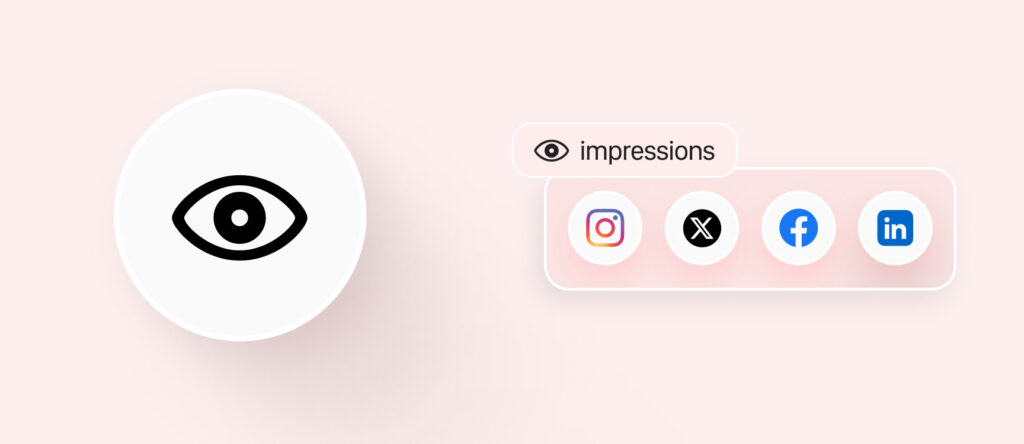
Impressions refer to the number of times your content is displayed to users. Unlike reach, which focuses on unique individuals, impressions count every time your content pops up on someone’s screen, whether they see it or not.
Imagine you post a captivating image on Instagram. If the same person scrolls past your post twice within an hour, that counts as two impressions. This metric provides insights into your content's visibility and potential reach.
Why do impressions matter?
Impressions are a crucial metric for several reasons:
- Content visibility: A high impression count suggests many people are seeing your content.
- Ad performance: For paid advertising, impressions are essential for measuring ad reach and campaign effectiveness.
- Algorithm impact: On platforms like Instagram and TikTok, impressions can influence how your content is ranked in the algorithm.
It’s important to note that while impressions are a valuable metric, they don’t necessarily equate to engagement. A high impression count doesn’t guarantee that people pay attention to your content.
How do you increase impressions?
- Optimize post timing: Publish content when your target audience is most active.
- Use eye-catching visuals: Compelling images and videos grab attention and increase impressions.
- Experiment with ad formats: Different formats can lead to higher impression counts.
- Leverage User-Generated Content (UGC): Sharing content created by your followers can expand your reach and increase impressions.
Understanding impressions and implementing these strategies can boost your content’s visibility and attract a larger audience.
Beyond Likes: Reach vs Impressions Explained
Want to see the impact of Birdeye on your business? Watch the Free Demo Now.
Reach vs. impressions: Which is more important?

The age-old question is: Is it better to have a wide reach or a high number of impressions? Both metrics are essential, but their importance varies depending on your specific goals.
The most effective strategy often involves balancing reach and impressions. While a wide reach is essential for brand growth, a high impression count can reinforce your message and increase the likelihood of conversions.
For example, focusing on reach might be more beneficial if your goal is to rapidly increase brand awareness. However, a higher impression count could be more effective if you're aiming to nurture existing customers and drive sales.
Remember: To truly measure the success of your social media efforts, you need to consider social media engagement metrics such as likes, shares, comments, and click-through rates.
Reach vs. impressions vs. engagement
While reach and impressions provide valuable insights into your content’s visibility, they tell only part of the story. To truly measure the impact of your social media efforts, you need to consider engagement.
Engagement refers to users’ interactions with your content, such as likes, comments, shares, clicks, and replies. It directly indicates how your audience responds to your content and how much value they derive from it.
Think of it like this: Reach is about getting your content in front of people, impressions are about how often it is seen, and engagement is how people interact.
Why they matter:
- Reach helps you understand your potential audience size.
- Impressions give you a sense of your content’s visibility.
- Engagement measures how well your content resonates with your audience.
Ultimately, a successful social media strategy involves a balance of all three. These three metrics are intricately linked.
A strong reach can lead to more impressions, which, in turn, can boost engagement. Conversely, high engagement can improve your content's visibility, increasing reach and impressions. It's a virtuous cycle.
Which metric to track and when?
- Track both reach and impressions regularly to understand your overall performance.
- Prioritize reach during brand awareness campaigns or when targeting a new audience.
- Focus on impressions when measuring ad performance, optimizing content for algorithms, or reinforcing brand messaging.
Role of reach and impressions on different platforms
The role of reach and impressions can vary slightly across different social media platforms due to their unique algorithms and user behaviors. Here’s a breakdown:

Facebook’s reach vs. impressions
- Reach: Critical for expanding your audience and building brand awareness. Facebook’s algorithm prioritizes content that generates high engagement, so increasing reach often requires creating highly shareable content.
- Impressions: Important for measuring ad performance and overall content visibility. Facebook’s ad platform allows for precise targeting, making impressions a valuable metric for campaign optimization.
Strategies to improve reach and impressions on Facebook
- Focus on high-quality visuals, engaging stories, and valuable information that resonates with your audience.
- Ensure your content is visually engaging and easy to consume on mobile devices.
- Join relevant groups to expand reach and build a community.
- Target your ideal audience with precise ads to increase visibility and conversions.
Instagram’s reach vs. impressions
- Reach: On Instagram, reach refers to the number of unique accounts that have seen your content. Its “accounts reached” measures how many people were exposed to your post or story.
- Impressions: This metric indicates the total number of times your content was displayed, regardless of whether it was seen by the same account multiple times.
Strategies to improve reach and impressions on Instagram
- Leverage Reels. Instagram’s algorithm favors Reels, so engaging short-form video content can significantly boost reach and impressions.
- Use popular and niche-specific hashtags can help your content discoverability.
- Engage with your audience. Respond to comments and direct messages and build relationships with your followers to increase engagement.
- Run Instagram ads to help you reach a wider audience and increase impressions.
- Experiment with different posting times to find when your audience is most active.

Twitter (X) reach vs. impressions
- Reach: Essential for expanding your audience and building brand authority. Twitter’s fast-paced nature means that reaching a wider audience quickly is crucial.
- Impressions: Important for measuring the overall visibility of your tweets, especially for brands using Twitter for customer service or real-time engagement.
Strategies to improve reach and impressions on Twitter (X)
- Leverage trending topics, experiment with different tweet formats (images, videos, polls, threads), and engage with your audience promptly to boost visibility and reach.
- Craft a compelling bio, use a high-quality profile picture, and curate your pinned tweets to showcase your best content and attract new followers.
- Create targeted lists to curate content and engage with specific audiences.
- Explore different ad formats (promoted tweets, promoted accounts, etc.) to find what works best for your goals.
LinkedIn reach vs. impressions
- Reach: Key for professional networking and building thought leadership. LinkedIn’s algorithm favors high-quality content that is relevant to its professional audience.
- Impressions: Important for measuring the visibility of your company updates and thought leadership content. LinkedIn’s focus on professional connections makes impressions valuable for assessing content reach within your industry.
Strategies to improve reach and impressions on LinkedIn
- Create long-form, in-depth content to establish yourself as an industry expert.
- Optimize your LinkedIn profile with relevant keywords to improve search visibility.
- Participate in relevant LinkedIn groups and engage with other users’ content to build relationships.
- Host live video sessions to connect with your audience in real-time.
YouTube’s reach vs. impressions
- Impressions: YouTube provides detailed impression data, including the number of times your video thumbnail was shown and the number of clicks it generated.
- Reach (similar metric): While not explicitly labeled as “reach,” YouTube offers metrics like “unique viewers” and “audience retention” to understand your content’s impact.
Strategies to improve reach and impressions on YouTube
- Create visually appealing thumbnails that accurately represent your video content.
- Experiment with different video lengths to find what works best for your audience.
- Make your videos accessible to a wider audience by adding captions and subtitles.
- Organize your videos into playlists to improve discoverability.
Snapchat’s reach vs. impressions
- Impressions: Snapchat primarily focuses on impressions, showing how often someone has viewed your Snap.
- Reach: While not directly measured, you can infer a reach by analyzing the number of unique viewers on your Stories.
Strategies to improve reach and impressions on Snapchat
- Utilize Lenses, Filters, and AR experiences to create interactive content.
- Encourage users to share your content by offering incentives or running contests.
- Collaborate with Snapchat influencers to reach a wider audience.
- Determine the optimal times to post based on your audience’s activity.
TikTok’s reach vs. impressions
- Reach: TikTok offers a metric called “Reached Audience,” representing the number of unique accounts that watched your video.
- Impressions: TikTok uses “Total video views” to measure impressions.
Strategies to improve reach and impressions on TikTok
- Stay updated on the latest trends and challenges.
- Grab attention within the first few seconds.
- Use popular sounds and music to enhance your videos.
- Reach specific demographics with precise targeting options.
Free social media tools that provide the best insights on reach and impressions:
‣ Facebook analytics
‣ Instagram Insights
‣ Twitter Analytics
‣ LinkedIn Analytics
Do reach and impressions matter in paid marketing?
Yes, they are fundamental to paid advertising. They help you measure the effectiveness of your ad campaigns and optimize your spending.
- Reach: Determines how many people saw your ad.
- Impressions: Indicates how often your ad was displayed.
But while reach and impressions are crucial for getting your ads in front of people, it’s equally important to consider how often they see them. Overexposure can lead to ad fatigue, diminishing the impact of your campaigns.
Effective frequency and ad fatigue
It’s essential to balance the number of times a user sees your content to avoid ad fatigue. This is known as effective frequency. Too few impressions might not create enough awareness, while too many can irritate users. So, consider the following suggestions to avoid that:
- Calculate effective frequency: Determine the optimal number of times a user needs to see your content before taking action.
- Monitor impression frequency: Use platform analytics to track how often users see your content.
- Vary ad creative: Rotate different ad variations to prevent ad fatigue.
- Target audiences precisely: Ensure your ads reach the right people to maximize impact.
By carefully monitoring reach, impressions, and engagement, you can refine your social media strategy and achieve better results.
5 Important paid marketing metrics to track
While reach and impressions can give you a basic understanding of ad visibility, they are often considered vanity metrics. Here are five more critical metrics to track for effective paid marketing:
- Click-through rate (CTR): Percentage of people who clicked on your ad.
- Conversion rate: Percentage of people who took a desired action (e.g., purchase, sign-up).
- Cost per click (CPC): Amount paid for each click on your ad.
- Cost per acquisition (CPA): Amount spent to acquire a customer.
- Return on ad spend (ROAS): Measure your ad campaigns’ profitability.
Did you know these 200+ social media acronyms?
Can viral marketing impact reach and impressions?
Absolutely! Viral marketing is all about maximizing reach and impressions. When a piece of content goes viral, it’s shared rapidly and widely, leading to a significant increase in both metrics.
However, it’s important to note that while viral content can skyrocket your numbers, it’s often unpredictable and difficult to replicate.
A successful marketing strategy should focus on building a loyal audience and creating consistently engaging content rather than solely relying on viral hits. While viral content can provide a temporary boost, sustainable growth comes from various factors, including reach, impressions, and engagement.
Reach vs. impressions: Are these only vanity metrics on social media?
Reach and impressions can be considered vanity metrics if they are isolated from other performance indicators. While they provide a basic understanding of your content’s visibility, they don’t offer insights into audience engagement or conversion rates.
However, reach and impressions can be valuable tools when used with other metrics and within specific campaign goals. For example:
- Brand awareness campaigns: Reach is crucial for introducing your brand to a wider audience.
- Content performance: Impressions can help identify high-performing content that deserves amplification.
Ultimately, the value of reach and impressions depends on how you use them and what other metrics you consider. It’s essential to combine them with engagement metrics, conversion rates, and ROI to get a complete picture of your campaign’s success.
FAQs on reach vs. impressions
Reach is the number of unique people who saw your content, while impressions are the total number of times your content was displayed.
Both are important but serve different purposes. Reach focuses on audience size, while impressions measure content visibility.
Create engaging content, use relevant hashtags, optimize posting times, consider paid advertising, and analyze your audience.
Organic reach is typically lower than paid reach due to platform algorithms. Paid ads allow for more control over targeting and impressions.
Yes, focus on creating high-quality content, engaging with your audience, using relevant hashtags, and optimizing posting times.
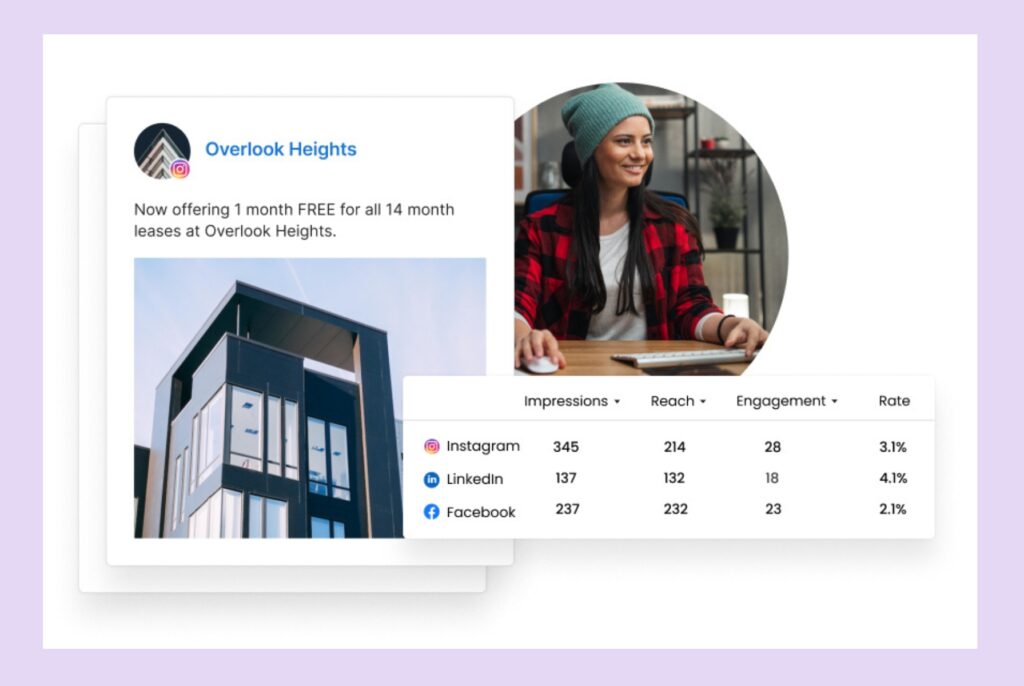
Birdeye Social – The tool you need to track your content’s reach and impressions
Understanding and optimizing reach and impressions is essential for the success of any social media strategy. While these metrics provide valuable insights into your content’s visibility, they are just one piece of the puzzle. To truly measure the impact of your social media efforts, it’s crucial to consider engagement, conversions, and return on investment (ROI).
Birdeye Social can be a powerful ally in your quest to master reach and impressions, as it benefits you with:
- Comprehensive tracking allows you to monitor reach and impressions across multiple social platforms from a single dashboard.
- In-depth analytics empowers you to gain actionable insights into audience behavior and content performance.
- Performance benchmarking lets you compare your performance against industry standards.
- AI-powered insights guide you to identify trends and optimize your strategy.
- Automate reporting and analysis, freeing up time for strategic planning.

Originally published




